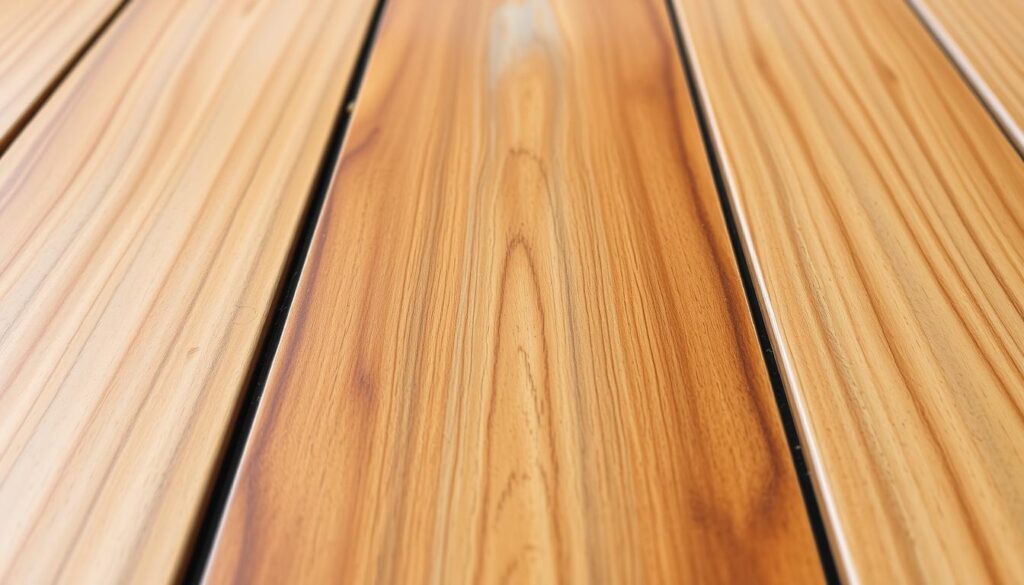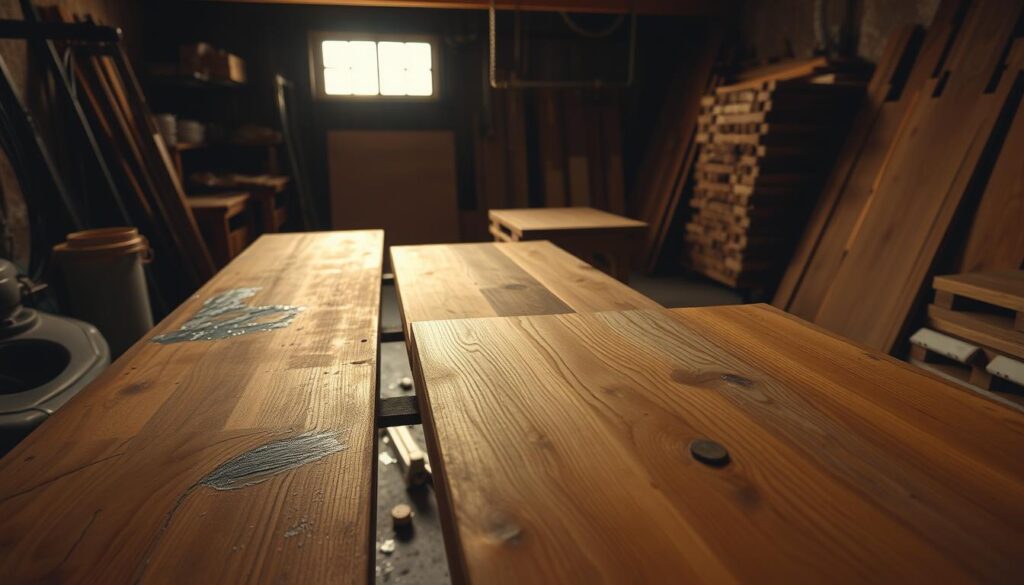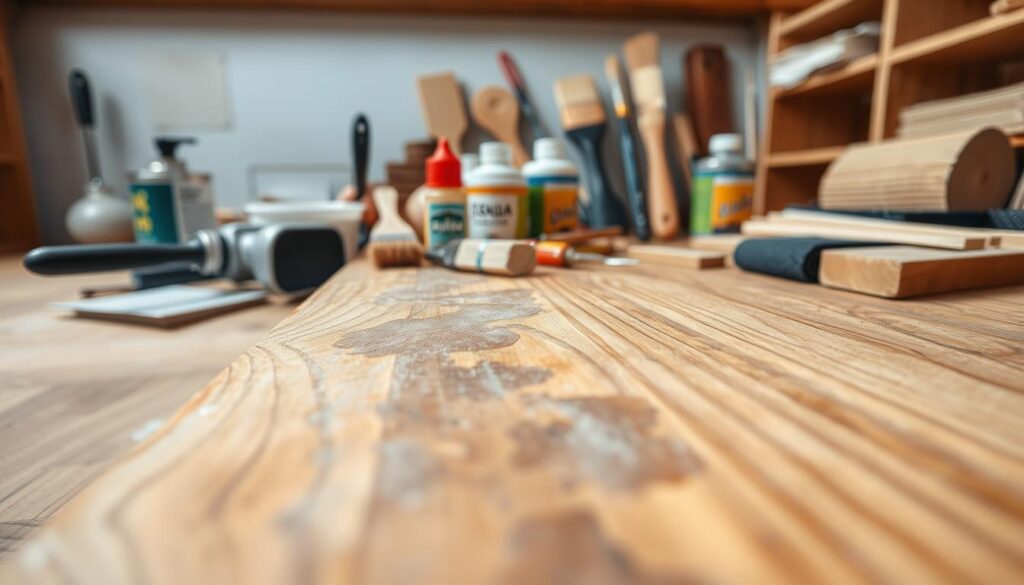Enhance the lifespan of your teak wood with our expert sealing tips. Learn the best techniques to protect and preserve the natural beauty of your teak furniture.
Sealing teak wood is key to protecting it from the elements and making it last longer. Teak wood is known for being tough and weather-resistant. But, sealing it adds extra protection against damage. It’s important to know how to protect your teak wood, whether it’s for outdoor or indoor use.

Sealing teak wood makes it look even better and keeps it safe for a long time. It stops moisture, UV rays, and other environmental factors from causing harm. Protecting your teak wood is easy with the right tools and materials. You also need to keep up with maintenance to keep the sealant working well.
Introduction to Sealing Teak Wood
Sealing teak wood is vital for keeping it durable and beautiful. It’s a favorite for outdoor furniture because it stands up well to weather. But, sealing it gives it even more protection and makes it last longer. Taking care of your teak wood is crucial to keep it looking great.
Key Takeaways
- Sealing teak wood protects it from the elements and extends its lifespan
- Teak wood protection is essential for preserving outdoor and indoor teak furniture
- Teak wood maintenance is necessary to ensure the sealant remains effective
- Sealing teak wood enhances its natural beauty and provides long-lasting protection
- Regular maintenance is necessary to keep teak wood in good condition
- Sealing teak wood is a simple process that can be done with the right tools and materials
Understanding Teak Wood Properties and Characteristics
Teak wood is known for its durability and resistance to rot, decay, and insects. Its natural oils act as a preservative, protecting the wood. These oils are crucial for its weather resistance.
The natural oils in teak wood help it withstand harsh weather. Its high oil content makes it perfect for outdoor use. It repels moisture, preventing rot and decay.
Natural Oils in Teak Wood
The natural oils in teak wood make it durable and weather-resistant. These oils protect the wood from moisture, insects, and UV radiation. Knowing about these oils helps us understand why sealing teak wood is important.
Weather Resistance Properties
Teak wood is highly resistant to weathering, thanks to its natural oils and dense grain. It’s ideal for outdoor furniture and construction. Its ability to repel moisture prevents rot and decay.
Why Teak Needs Sealing
Even though teak wood is durable, sealing it can enhance its durability and appearance. Sealing provides extra protection against moisture and UV radiation. Understanding teak wood’s properties is key to maintaining it.
Knowing about teak wood’s properties helps us appreciate its benefits. Whether for outdoor furniture or a deck, teak wood is a durable and attractive choice. With proper care, it can last for years.
| Teak Wood Properties | Benefits |
|---|---|
| Natural Oils | Preservative, protects against rot and decay |
| Weather Resistance | Repels moisture, prevents rot and decay |
| Dense Grain | Provides additional protection against moisture and UV radiation |
Benefits of Sealing Teak Wood
Sealing teak wood brings many advantages, like better protection and a nicer look. It keeps your furniture safe from too much moisture, preventing warping or cracking. This also helps keep the wood’s natural color bright and appealing.
The main points of sealing teak wood are:
- Enhanced protection against rain, sun, and extreme weather
- A richer, more vibrant color that lasts
- Less chance of warping or cracking, keeping furniture stable
- Easier to clean and maintain, with a surface that resists stains
Video source from Youtube
Knowing the benefits of sealing teak wood helps you take better care of your furniture. With the right sealants and a bit of upkeep, your teak wood furniture can last for many years. It will add beauty and durability to any room or outdoor area.
Sealing teak wood is a simple yet effective way to protect your investment and enjoy your furniture for years to come.
Essential Tools and Materials for Sealing Teak Wood
To seal teak wood well, you need the right tools and materials. This means picking the best teak wood sealants and finishes for protection and look. Knowing the differences between sealants and finishes helps you choose the right one for your project.
Make sure you have the tools, like brushes or rollers, and safety equipment, such as gloves and goggles. This makes the job safe and effective. There are many teak wood sealants and finishes to choose from, like oil-based and water-based ones, each with its own benefits.
Recommended Sealants and Finishes
- Oil-based sealants for enhanced durability
- Water-based finishes for a natural look
- Hybrid options for a balance between protection and appearance
Required Tools Checklist
- Brushes or rollers for applying sealants and finishes
- Gloves and goggles for safety equipment
- Drop cloths or tarps for protecting surrounding surfaces
Having the right tools and materials, like teak wood sealants, finishes, and safety equipment, is key. This ensures your teak wood sealing project is a success and safe.
Preparing Your Teak Wood for Sealing
To get your teak wood ready for sealing, follow a few important steps. First, clean the wood to remove dirt and old finishes. Then, sand it to make the surface smooth. This ensures the sealant works well and protects the wood for a long time.
Start by getting the right tools, like a soft-bristled brush, mild detergent, and a hose. Sweep the wood to get rid of loose debris. Mix the detergent with warm water and clean the wood from top to bottom. Rinse it well with the hose to get rid of soap.
Next, sand the wood to make it smooth. This is key if the wood is rough or weathered. Use fine-grit sandpaper to sand in the wood grain direction. After sanding, wipe the wood with a clean cloth to remove dust.
Here are some important steps for preparing teak wood for sealing:
- Always clean the teak wood surface before sealing to remove dirt and grime.
- Use a mild detergent and avoid using harsh chemicals or abrasive cleaners.
- Sand the surface to smooth out any rough spots or weathered areas.
- Rinse the surface thoroughly with a hose to remove any soap residue.
By following these steps, you can get your teak wood ready for sealing. This will help you achieve a beautiful, lasting finish that protects your furniture for years.
| Step | Description |
|---|---|
| 1 | Clean the teak wood surface with a mild detergent and water. |
| 2 | Rinse the surface thoroughly with a hose to remove any soap residue. |
| 3 | Sand the surface to smooth out any rough spots or weathered areas. |
| 4 | Wipe away any dust or debris with a clean cloth. |
Step-by-Step Guide to Sealing Teak Wood
To seal teak wood successfully, follow a step-by-step guide. Start by preparing the surface and applying the sealant as the manufacturer suggests. Then, let it dry completely.
Choosing the right application method is key. You can use a brush, roller, or spray. Each has its own benefits and drawbacks. Pick the one that fits your project and personal style best.
Here are some important things to remember during sealing:
- Surface preparation: Clean the surface well for a strong bond.
- Application methods: Select the best method for your project and desired finish.
- Drying time: Follow the drying time suggested by the manufacturer, considering temperature and humidity.
Drying time is crucial. Make sure the sealant dries fully before adding more coats or using the surface. The drying time depends on the sealant type and the environment. By following the instructions and considering your specific situation, you can seal your teak wood effectively.
| Sealant Type | Application Method | Drying Time |
|---|---|---|
| Oil-based | Brush or roller | 2-4 hours |
| Water-based | Spray or roller | 1-2 hours |
Common Mistakes to Avoid When Sealing Teak
Sealing teak wood can protect it from the elements and make it last longer. But, there are mistakes to avoid for the best results. Choosing the wrong sealant is a big mistake.
Watch out for oversaturation, which can make the wood sticky or slow to dry. Also, don’t apply sealant in sunlight or rain. These conditions can harm the sealant’s effectiveness. Knowing these issues can help you seal your teak wood successfully.
Common Mistakes and Their Solutions
- Applying too much sealant, leading to oversaturation
- Not choosing the right product selection for the specific type of teak wood
- Applying sealant in bad weather, which can lead to common mistakes and a poor finish
Avoiding these mistakes can ensure your teak wood is well-sealed and protected. Always follow the manufacturer’s instructions and avoid oversaturation. With the right product selection and care, your teak wood will last for years.

Best Practices for Sealing Teak Wood
To seal teak wood well, follow some key practices. Choose the right product selection and apply sealant in a well-ventilated area. Avoid oversaturation. These tips and avoiding common mistakes will help you seal your teak wood successfully.
| Mistake | Solution |
|---|---|
| Oversaturation | Apply thin coats of sealant, allowing each coat to dry before applying the next |
| Wrong product selection | Choose a sealant specifically designed for teak wood and follow the manufacturer’s instructions |
| Bad weather | Apply sealant in a well-ventilated area, avoiding direct sunlight and rainy conditions |
Maintaining Sealed Teak Wood Furniture
Keeping sealed teak wood furniture in top shape requires regular maintenance. This means cleaning it often to get rid of dirt and checking it for wear or damage. You might also need to reapply sealant from time to time.
To keep your furniture looking great, here are some tips:
- Use a mild soap and water to clean the surface regularly.
- Check for signs of wear or damage, like cracks or fading, often.
- Apply sealant when needed to keep it protected from the elements.
By following these steps and doing regular maintenance, you can make your sealed teak wood furniture last longer. Always check your furniture and clean it when needed. This will help it stay beautiful and durable for years.
With the right care, your sealed teak wood furniture can be a stunning part of your space for a long time. Regular cleaning and inspections can catch problems early. This saves you time and money in the long run.
Troubleshooting Teak Sealing Problems
Sealing teak wood can lead to several issues, affecting its look and durability. It’s important to solve these problems to keep teak wood furniture looking good. Common problems include discoloration, uneven application, and peeling or flaking.
Figuring out the cause of these problems is key to finding a solution. For example, discoloration might be due to the sealant or the environment. Uneven application can leave some wood unprotected. To fix these, you might need to reapply sealant, try a different product, or change how you apply it.
Common Issues and Solutions
- Discoloration: Check the sealant’s ingredients and environmental factors, and consider reapplying a new sealant.
- Uneven application: Ensure the wood surface is clean and dry, and apply the sealant according to the manufacturer’s instructions.
- Peeling and flaking: Inspect the sealant’s condition and consider reapplying a new coat or using a different product.
Knowing how to solve these problems helps keep your teak wood furniture looking great. Regular checks and maintenance can prevent these issues. Always follow the manufacturer’s instructions and be careful when using sealants and chemicals.

Conclusion: Ensuring Long-Lasting Protection for Your Teak Wood
Sealing and maintaining your teak wood is key to keeping it beautiful and durable. By following the guide in this article, your teak furniture or decking will stay protected. Remember, the right care, materials, and regular upkeep are essential for keeping your teak looking great.
Using the right sealing techniques helps protect your teak from the weather. This prevents damage and keeps it looking good. By doing this, your teak will stay beautiful and strong for many years, becoming a valued part of your home.
FAQ
What is the importance of sealing teak wood?
Sealing teak wood is key to making it last longer and look better. It has natural oils that fight off rot and bugs. But, sealing adds extra protection and keeps its beauty.
What are the benefits of sealing teak wood?
Sealing teak wood has many perks. It keeps moisture out, stops warping, and keeps the wood’s color. It also makes cleaning easier and prevents stains.
What tools and materials are needed for sealing teak wood?
To seal teak wood, you need the right sealant, brushes or rollers, and safety gear. Picking the right sealant is important for the best look and protection.
How do I prepare teak wood for sealing?
First, clean the wood to get rid of dirt and old finishes. You might need to sand it too. This makes sure the sealant sticks well and works long.
What are the steps for sealing teak wood?
To seal teak wood, apply the sealant with a brush, roller, or spray. Let it dry as the maker says, and you might need to do it more than once.
What are common mistakes to avoid when sealing teak wood?
Don’t soak the wood too much, as it can get sticky or take too long to dry. Avoid sealing in the sun or rain. Also, pick the right sealant for your wood and use.
How do I maintain sealed teak wood furniture?
To keep sealed teak wood furniture in good shape, clean it often. Check it for damage and reapply sealant when needed. This keeps it looking great for longer.
How do I troubleshoot issues with teak wood sealing?
If you run into problems like color changes, uneven looks, or flaking, figure out why. Then, fix it by reapplying, changing products, or how you apply it.
Read also : What Does Teak Wood Look Like? Explore the Characteristics
